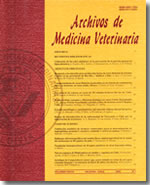Caseous Lymphadenitis (CLA) in sheep at the XI Region of Chile
Main Article Content
Abstract
The aim of this study was to determine the presence of Caseous Lymphadenitis (CLA) in sheep of the XI Region, Chile. The survey was carried out at the INDUCAR abattoir of Coyhaique, XI Region, Chile, during August and November 2002. A total of 1,397 sheep of different categories (lambs, hogget, ewes, wether and rams) from different sources and ages were examined. Age was estimated based on dental chronometry. Hot carcasses were examined by visual inspection and all the lymph nodes were palpated. The lungs, liver and kidney were also examined. The lymph nodes and organs with CLA - like lesions were removed and material from the periphery of the abscess was collected with sterile swabs, sotred in Stuart transport medium and sent to the Institute of Microbiology, Faculty of Sciences at the University Austral of Chile. Half lymph nodes samples were also sent weekly for culture. Positive cultures to Corynebacteriumpseudotuberculosis were only obtained from lesions in adult animals. From 105 samples cultured, 81 were positive. The prevalence of CLA in the adult animals was 11.6% and decreased to 5.8% when the whole examined population was considered. The frequency of presentation of CLA increased with the age of the animals. The lymph nodes more frequently affected were the superficial lymph nodes (54.3%). Individually, the most commonly affected lymph nodes were the mediastinal (35.1%), followed by the prescapular nodes (30.8%). In relationship to the origin of the affected animal, most were from the Ñirehuao and Río Cisnes sheep farms and the Balmaceda and El Claro sectors (81.5%). Based in our findings of macroscopic lesions in the affected lymph nodes and lung and their positive cultures to C. pseudotuberculosis, it can be concluded that the disease Caseous Lymphadenitis is present in the XI Region of Chile.

